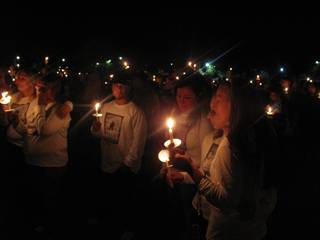Thursday, Dec. 8, 2011 | 7:32 p.m.
North Las Vegas holds vigil for three girls
KSNV coverage of candlelight vigil held for Mia Decker, a North Las Vegas girl who died after being stuck by a 78-year-old driver while walking in a crosswalk. Two other girls were hit in the incident and one remains hospitalized in critical condition, Oct. 28, 2011.
Sun Coverage
Of the 414 pedestrian accidents in Clark County last year, 105 of them involved a child between the ages of 1 and 15, while 28 involved someone ages 16 to 20.
Erin Breen, the director of UNLV’s Safe Community Partnership, said she was shocked to see those numbers so high, but what was even more surprising was that in the majority of those crashes, the motorist was at fault. Normally, motorists are only at fault in about a quarter of accidents.
The numbers highlight part of Las Vegas’ problem with pedestrians, an issue that has become major news in recent months after a number of high-profile accidents, including one that killed Faith Love, a 12-year-old who was trick-or-treating on Halloween.
“While it’s never a good thing to lose children, it’s a good thing to have everyone’s attention,” Breen said.
For Michele Terry, the attention is personal. Her 6-year-old daughter, Mia Decker, was killed in a North Las Vegas crosswalk Oct. 21, the first of the recent string of accidents.
But Terry has decided to put the accident and the attention to good use. She and Love’s mother have talked, swapping stories and consoling each other.
And Thursday, Terry joined a press conference to discuss traffic safety measures being taken by the Regional Transportation Commission and law enforcement.
She said she hopes her story will help prevent future tragedies. “I don’t want another accident like this to impact anyone else unnecessarily,” she said.
Her daughter would have turned 7 on Nov. 30, she said. “And I spent my day at the cemetery, a place no one should have to spend their child’s birthday.”
Terry said she is now far more protective of her remaining daughter, who is 13. And it’s more difficult for her to walk to work, but she still gets out and walks through the neighborhood, even visiting the crosswalk where the accident occurred.
“I just really hope people will take responsibility,” she said. “Everybody needs to take responsibility, it’s not just the drivers or pedestrians.
The Regional Transportation Commission thinks it knows how to make streets safer for pedestrians. But it’s not going to be easy or cheap.
The commission has spent more than a year studying and developing a policy for what transportation geeks call “complete streets” – the idea that a street can be designed to be friendly for all modes of transportation.
The final report and recommended policy changes should be ready in the spring, General Manager Jacob Snow said.
It’s not just about adding bike lanes to existing streets. Instead, it often involves tearing out and replacing sidewalks and medians; on major streets it can involve adding bus lanes.
The prime examples are two streets that are served by the RTC’s new express bus routes: Grand Central Parkway in downtown Las Vegas and Water Street in downtown Henderson.
Both streets are narrow to slow traffic and have attractive new bus stops and landscaping. The RTC has done similar work on Boulder Highway and is working on Sahara Avenue.
Those projects are expensive and were largely funded with federal stimulus money. With the federal government cutting back, it’s not clear how many future projects will be possible.
Plus, with new development in Southern Nevada greatly reduced in the recession, it’s not clear that a new policy of building complete streets will make much of an impact in new areas for a while.
Snow blamed Las Vegas’ pedestrian problems on traffic engineers and land use planners, who have designed developments in a way that creates extra traffic. But those decisions were made primarily because residents demanded faster roads and closed off neighborhoods.
Major roads were designed 50 or more years ago, Snow said, and engineers just wanted to move traffic as quickly as possible.
Plus, developers built communities surrounded by block walls that create a tunnel-like feeling for drivers on arterial roads and make it difficult for pedestrians and bicyclists to access neighborhoods, he said.
Going forward, Snow promises his agency will work to widen sidewalks, add street landscaping and parking and build roundabouts – all efforts to make traffic move more slowly.
But Snow said lower speed limits and slower traffic doesn’t necessarily mean it will take longer for people to get to their destinations.
More important than speed limits, traffic signalization is actually what makes people’s commutes faster, and it is easier to sync lights if the speed limit is lower, Snow said.


Join the Discussion:
Check this out for a full explanation of our conversion to the LiveFyre commenting system and instructions on how to sign up for an account.
Full comments policy